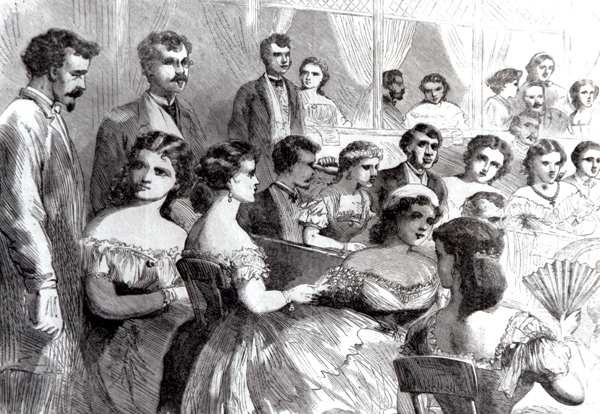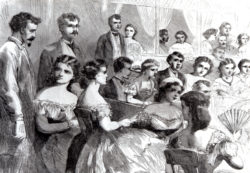Opera and Ballet
New Orleans has an almost unbroken tradition of opera that began in 1796 and first documented ballet was presented just three years later.

Courtesy of The Historic New Orleans Collection
A Creole Night at the French Opera House. Waud, Alfred Rudolph (Artist)
New Orleans has an almost unbroken tradition of opera that began in 1796. Indeed, the city is the birthplace of opera in the United States. The first documented ballet was presented three years later. Especially during the nineteenth century, New Orleans was also a leader in the development of theaters, boasting some of the largest and most sophisticated in the country. During the twentieth century, world wars, economic depressions, and natural disasters failed to dampen the popularity of opera and ballet in New Orleans. The state as a whole continued to develop and contribute new talent to the national and international stage.
Opera in the Nineteenth-Century Louisiana
The first known opera in New Orleans, André Ernest Grétry’s Sylvain, was presented on May 22, 1796, at the Théâtre St. Pierre, on St. Peter Street between Royal and Bourbon streets. Since that time, with only a few exceptions, New Orleans has had a resident company for an established opera season. The St. Pierre closed in 1803, and in 1808 the St. Phillipe Theater opened on the corner of St. Philip and Royal streets. The opening night performance of January 30, 1808, presented the American premiere of Éitenne Méhul’s opera Une Folie. The repertoire slowly expanded to include such composers as Nicolo Isouard, Nichoas Dalayrac, and Francois Boieldieu, as well as Italian composers Giovanni Paisiello and Luigi Cherubini.
In 1815 the Théâtre d’Orléans opened. Located in the French Quarter on Orleans Street between Royal and Bourbon streets, it fell prey to fire, which was an ever-present danger to nineteenth-century buildings made of wood. It was rebuilt and opened again in 1819 under the management of John Davis. Davis, and later his son Pierre, imported singers, musicians, and dancers. Until the Civil War, the Théâtre d’Orléans remained the primary venue for opera. Ever the impresario, rather than disbanding his company during the hot and humid New Orleans summer months, John Davis organized tours of northeastern cities beginning with the 1826/27 season. As a result, the Théâtre d’Orléans introduced French opera to New York and other cities. Unfortunately, these “touring” performances are frequently credited as being American premieres, while the earlier New Orleans dates have failed to gain the recognition they deserve.
Davis was not the only impresario in New Orleans. In 1824, James Caldwell opened his Camp Street Theatre and appealed to the English-speaking population. Caldwell produced Carl Maria von Weber’s Der Freischütz and Wolfgang Amadeus Mozart’s Don Giovanni and Le Nozze di Figaro. By 1835 both the Théâtre d’Orléans and the Camp Street Theatre competed to introduce Giocomo Meyerbeer’s Robert le diable. Caldwell opened his St. Charles Theatre in 1835. With a seating capacity of 4,100, it was considered one of the finest in the country. Caldwell brought from Europe such musicians as Thomas Cripps of England to serve as chorus master. Even more important was the fact that he imported Italian opera companies that were performing in Havana. He staged the U.S. premieres of operas by Vincenzo Bellini, Gaetano Donizetti, and Gioachino Rossini. Caldwell’s introduction of such operas resulted in an expanded rivalry between the two impresarios and their theaters. The rivalry came to a tragic end when the St. Charles Theater succumbed to fire in March 1842.
With the glamorous St. Charles Theatre a ruined memory, the Théâtre d’Orléans took center stage until the eve of the Civil War. Between 1841 and 1860, there were 1,550 performances of some 109 different operas by thirty-five composers. The Théâtre d’Orléans introduced the latest works produced in Europe to American audiences through their premieres and touring productions.
As the 1850s ended, the famed Théâtre d’Orléans was in poor condition. The combination of the building’s physical condition and a dispute between the theatre’s owner and impresario Charles Boudouquisé resulted in a decision to build a new opera house. Constructed in a matter of months, the new theater—known as the French Opera House—opened on December 1, 1859, with a performance of Rossini’s opera, Guillaume Tell. Soon, however, the Civil War challenged the operatic tradition of New Orleans. Opera would not flourish again until the 1870s, when the city resumed its preeminence in opera production in the United States by presenting premieres of works by Charles Gounod, Édouard Lalo, and Jules Massenet. In the early twentieth century, the French Opera House hosted the first visit of the Metropolitan Opera to New Orleans (1901), as well as the company’s 1905 visit that introduced Richard Wagner’s opera Parsifal to the region.
In December 1919, fire struck the French Opera House. Within hours it joined the ranks of the Théâtre d’Orléans, Crisp’s Gaiety, the German National Theatre, and the second St. Charles Theatre, which had previously succumbed to fire.
Ballet in Nineteenth-Century Louisiana
The first known ballet presented in New Orleans was in 1799, and by the 1820s John Davis was presenting some of the best ballet in the United States. One of the reasons for the enormous popularity of ballet in New Orleans is that ballet—with its reliance on the art of pantomime—had universal appeal to a linguistically diverse city with a population of 20,000 (half African American) and two opera houses. Davis, the proprietor of the Orleans Theater, went to Europe in 1822 to recruit both dancers and singers. He returned with performers such as Jean Rousset, the premier danseur at Paris’s Porte Saint-Martin theater. Also returning with Davis was Monsieur Olivier, a pupil of ballet at the Paris Opera, and his young dancer wife.
By the spring of 1824, Rousset and the Oliviers, after returning from performances in Havana, presented two ballets by Dauberval: Annette et Lubin and La Fille mal gardée. The April 1, 1824, performance of La Fille mal gardée is believed to be the first performance of that work in the United States. In 1839, “Madame” Lecompte and her famed corps de ballet arrived in New Orleans. Her entourage included a father and son unknown to the American public—Jean and Marius Petipa, who were later teachers and choreographers at the Imperial Ballet in St. Petersburg. Among the company’s offerings were scenes from Meyerbeer’s Robert le diable, which was critical to the development of nineteenth-century ballet music and technique.
Opera and Ballet in Twentieth-Century Louisiana
After fire destroyed the French Opera House in 1919, New Orleans welcomed visiting opera companies. In 1943, a group of music lovers under the leadership of Walter Loubat established the New Orleans Opera House Association. Initial performances were held outdoors. However, the Municipal Auditorium soon became its permanent home and served in that capacity through 1973, when the Theater for Performing Arts opened. Two critical positions were filled by Louisiana residents. Former Metropolitan Opera conductor and Louisiana State University faculty member Louis Hasselmans was recruited, as was New Orleanian Leila Haller, formerly of the Paris Opera Ballet. Renata Cellini was recruited as director in 1954. Recognizing the importance of training young singers for the operatic stage, Cellini launched the Experimental Opera Theatre of America. Although it was short-lived (1956 and 1958–1960), its impact was significant. As performing arts activities increase throughout the state, so do opera productions. The Jefferson Performing Arts Society regularly presents opera, and Baton Rouge established Opéra Louisiane in late 2006.
Organizations such as Ballet Alexandria, Baton Rouge Ballet Theatre, Delta Festival Ballet, Hysell Ballet, Lafayette Ballet Theatre, Lake Charles Civic Ballet, and the New Orleans Ballet Association continue to nurture ballet throughout the state.The contributions of New Orleans and Louisiana to the world of opera and ballet, both locally and to the United States, signal the importance of nineteenth-century of New Orleans as a geographic and economic crossroads, while the activities of the twentieth century clearly indicate how firmly the roots of opera and ballet were planted. The pioneering efforts of both the nineteenth and twentieth centuries are also indicative of a region that was not isolated socially or culturally.
